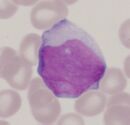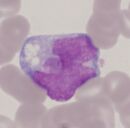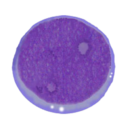Atypical patterns of primitive marker expression in acute myeloid leukaemia: Difference between revisions
From haematologyetc.co.uk
No edit summary |
No edit summary |
||
| Line 26: | Line 26: | ||
---- | ---- | ||
<div id="AML_MonoPic">''' | <div id="AML_MonoPic">'''Recognition of blast cells with monocytic differentiation'''</div> | ||
[[Image:AMLM5A.jpg|130px|caption]] '''A''' monoblastic AML | [[Image:AMLM5A.jpg|130px|caption]] '''A''' monoblastic AML | ||
Revision as of 17:35, 17 December 2023
| Table: Less frequent patterns of primitive phenotype |
|---|
| While blast cells typically cause low side scatter of light and have an expression of CD45 that is lower than normal lymphocytes or monocytes, atypical patterns may be encountered. The more frequent patterns are described below. |
| AML with monocytic differentiation In AML with monocytic maturation those primitive cells with more mature monocytic features may show higher side scatter (consistent with their size and cytological features) and some or all of the blast cells may also have high expression of CD45 (comparable with normal or CMML monocytes). Such cases may be difficult to distinguish from typical or transforming CMML. It is important to compare with clinical and morphological features to ensure appropriate classification (See details). |
| Acute promyelocytic leukaemia Cells of APL can vary in size and granularity an will often express a range of side scatter features may resemble those of maturing granulocytic cells, similarly CD45 expression may be similar to maturing granulocytic cells. The distribution of cells will be abnormal however and may variably include cells with wide range light scatter features that differ from those of typical blast cells. It is important to distinguish APL blasts from reactive myeloid cells or (in some cases) from cells of MDS. Morphological examination is essential, but consider also the pattern of additional markers (See details). |
| Other patterns While most frequently blast cells with myeloid differentiation form a relatively homogenous group with moderately weak CD45 expression, in some cases very weak expression or a wider spread of weak expression my be observed, often more closely resembling appearances of ALL or evn non-haematopoietic tumours. |
 A monoblastic AML
A monoblastic AML
 B monocytic AML
B monocytic AML
- Panel A: where cells have a monoblastic differentiation they are most frequently large often with abundant cytoplasm; monoblasts tend to express markers of primitive phenotype, while typical antigens of monocytic differentaition may be variable or weakly expressed.
- Panel B: Where cells undergo more appreciable monocytic differentiation they cells tend to have stronger CD45 expression and often express typical monocyte antigens, primitive markers may be variably expresssed or absent.
- Mixed patterns of monoblastic and monocytic differentiation within the same case are also frequently found.
- Correlation of immunophenotype with morphology and clinical features may be necessary to accurately identify such cells as blasts.
Typical APL has cells that are hypergranular (A) or may be the microgranular variant (B) generally the cells will have a range of granulation or nuclear appearance. While CD45 expression tends to be weak, in almost all cases the variable morphological features cause a wide range of side-scatter with the abnormal cells often forming a "cloud" extending toward the neutrophil area. This can make the cells (particular hypergranular forms) difficult to distinguish from reactive myeloid populations (or occasionally from MDS). Absent HLA-DR on APL cells can help distinguish from reactive cells (expressing HLA-DR), but correlation with morphology and clinical features and other confirmatory tests are essential to the recognition of APL.
